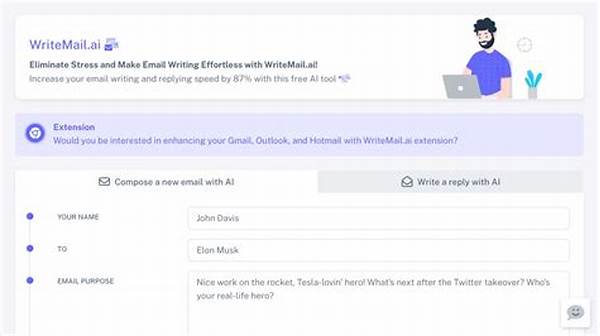How AI Email Tools Cut Response Time in Half
Read More : Best Ai Tools For Content Creation And Marketing
The rise of artificial intelligence has brought transformative changes to various aspects of our daily lives and professional environments. One area that has significantly benefited is email communication. Ask anyone who deals with a lot of emails, and they’ll tell you that responding promptly while maintaining a high level of accuracy is a delicate balancing act. This is where AI email tools come into the picture, offering the potential to “cut response times in half” and effectively manage communication tasks. Users are finding that these tools do more than mere automation; they act as digital assistants designed to streamline and optimize workflows, thereby enhancing productivity. The keyword here is efficiency—a buzzword in today’s fast-paced world that AI promises to deliver with minimal hiccups.
Let’s delve into the transformational journey that AI tools are currently embarking on when it comes to managing emails. Imagine this: hours shaved off the clock in responding to workplace emails, allowing you more time to focus on strategic and creative pursuits. These time savers are not the generic spam filters or rudimentary sorting algorithms we once knew. Instead, they come loaded with features like natural language processing, machine learning, predictive analytics, and even user personalization. This broadening of AI capabilities spells good news for businesses looking to revolutionize their email operations.
But how do these email tools work their magic? At the heart of it, AI email tools can automatically prioritize emails based on content and past interactions, compose drafts based on context and tone, and even suggest replies. This allows users to handle important communications while the tool manages repetitive queries automatically. For instance, emails concerning meeting confirmations, order tracking, or FAQs can often be seamlessly addressed by AI. Not only does this save plenty of time, but it also ensures that responses maintain a level of uniformity and professionalism—a double win!
Even as AI continues to develop, the question that lingers is, “How do AI email tools cut response time in half for diverse work settings?” The proof lies in various real-world applications and user testimonials. Organizations across industries are reporting improved customer satisfaction rates and operational efficiencies as a direct result of adopting these tools. However, it’s not solely about response time; the adaptability and learning capabilities of AI mean that it constantly evolves and becomes more efficient with each interaction. Intriguingly, a Gartner study even highlighted a 60% time reduction in managing emails for teams that incorporated AI solutions—a statistic that’s not only impressive but a game-changer in modern business environments.
The Effectiveness of AI Email Tools in Today’s Workplace
—Discussion on AI Email Tools: Cutting Through the Inbox Chaos
The digital landscape is ever-evolving, and one of the most exciting additions in recent years has been the emergence of AI email tools. These smart tools have started to redefine what’s possible when it comes to managing electronic communications. Anyone who has spent entire mornings wading through an overfilled inbox knows the struggle. A recent survey suggests that the average office worker spends around 28% of their workweek managing emails. But here’s the kicker: AI email tools promise to reduce this time drastically, some claims even boast “cutting response times in half.”
So how do these AI tools manage to perform such wizardry? Their effectiveness can be attributed to their ability to learn and adapt. Unlike static programs of the past, AI-equipped tools can analyze patterns in your email habits and finetune their operations accordingly. They perform tasks such as sorting emails into categories, prioritizing urgent messages, and even drafting initial responses for review. The result is a streamlined process that allows employees to focus on more critical tasks, boosting overall productivity and job satisfaction.
More than just an organizer, these AI tools act as personal email assistants. They scour through emails, identify important tasks, and flag them for you. Whether it’s setting appointment reminders or drafting routine responses, these tools save time and reduce mental clutter. It’s akin to having a savvy secretary who understands each communication’s nuances, streamlining the process without needing constant supervision. No more tethering yourself to your inbox; instead, AI offers an organized approach that enhances work-life quality.
Another noteworthy feature is AI’s capability to learn from experiences. Over time, AI systems become increasingly efficient at executing tasks, offering tailored solutions that align with your personal and professional needs. Ultimately, the burning question remains: “How do AI email tools cut response time in half while maintaining accuracy and personalization?” The multifaceted nature of AI ensures that each email interaction does not just occur in isolation but enriches the system’s future responses. It’s a cycle of continuous improvement that promises to redefine workplace productivity as we’ve known it, making your inbox not just a to-do list but a productivity portal.
Real-world Impacts of AI in Email Management
Real-life Testimonials
Organizations across different sectors have started to embrace these AI tools, providing testimonial after testimonial about the benefits they’re experiencing. A manufacturing firm in Ohio reported that they reduced their customer service email response time by 53% within three months of utilizing AI tools. Similarly, a tech company in California saw an increase in customer retention, attributing this to the enhanced communication made possible by AI email tools.
How AI Learns and Adapts to Improve Email Responses
AI email tools not only make email management more efficient but also significantly improve response quality. By using machine learning algorithms, these tools analyze past interactions to deliver more contextually aware and timely responses. This ability to “learn” from previous messages prevents the occurrence of redundant or irrelevant responses, thus maintaining the clarity and professionalism that businesses strive for. It’s a leap beyond mere automation into a realm where each email interaction enriches future communication, creating a continuously evolving dialogue between AI tools and users.
The confluence of technology and communication through AI offers exciting prospects and numerous challenges. Yet, the possibilities it unfolds for enhancing personal productivity, providing better customer interactions, and adapting to various communication needs suggest that AI email tools are not just an innovation of the moment. As they continue to prove their efficiency and adaptability, these tools could redefine yet another staple of the modern workplace: email communication, ultimately revolutionizing how businesses operate and how professionals manage their time effectively.
Tips for Maximizing AI Email Tools
—Articles, Discussions, and Tips: Navigating AI Email Tools
The modern shift towards AI-powered email tools is undeniable, and their potential for revolutionizing communication is being increasingly recognized. As someone deeply invested in tech trends, I must say that understanding how AI email tools cut response times in half is not just about embracing innovation but also about realizing its implications. These tools promise not only to enhance efficiency but also to redefine communication landscapes across industries.
The discussion around AI email tools often revolves around their capacity to significantly cut down response times. But this innovation comes with an additional layer of complexity: how it transforms the dynamics of workplace communication. In essence, AI tools become more than just a part of the software ecosystem; they become virtual team members who streamline communication. By automating repetitive email tasks, AI gives humans time to focus on strategic priorities. This scenario resonates well in sectors that demand agility and responsiveness, such as customer service and sales, where quick responses are crucial. What makes AI email tools truly revolutionary is their ability to make instant communication tangible, eliminating traditional constraints like time zones and working hours.
Considering the underlying mechanics of these tools brings us to a fascinating aspect: their ability to continuously learn and adapt. Utilizing machine learning algorithms and sophisticated data analytics allows these tools to improve their functions over time. That an AI email tool can learn from different user interactions how to prioritize information, identify sentiment, and offer suitable replies is akin to an intelligent assistant launched into tackling endless waves of emails. This learning adaptation extends beyond simple automation; it essentially means that AI becomes a formative agent for operational efficiencies, further enhancing how AI email tools cut response time in half.
The growing appeal of AI tools goes beyond the novelty factor; it lives in the value creation they bring to work processes. Various case studies and anecdotal evidence from businesses that have implemented these tools underline a powerful narrative of increased productivity and client satisfaction. When traditional inefficiencies in workplace communication are mitigated using AI solutions, employees experience improved mental space, which directly impacts customer engagement positively. Stories like these fortify the understanding of how AI email tools cut response time in half while setting new standards in digital-first workplace communication.
While these examples provide a compelling picture, this also leads us to ponder the ethical considerations around using AI—data privacy, biases in decision-making algorithms, and reliance on technology over human intuition. As exciting as the applications are, organizations need to ensure responsible AI use. Implementing ethical guidelines in developing these tools becomes crucial to safeguard user interests without compromising on innovation. Conversations around ethics encourage a balanced approach where technology collaborates with humans to improve, not replace, their capabilities. This power balance is essential if we wish to construct resilient AI solutions that genuinely lift the communicative and operational potential of businesses globally.
In conclusion, embracing AI email tools is not just an investment in modern technology; it signifies a strategic partnership with advanced digital counterparts that can transform communication and productivity. They are worthy allies in the digital age—a period defined by its pursuit of efficiency, productivity, and seamless interactions. Understanding how these tools reshape operations today is key to unlocking sustainable success in a rapidly evolving business landscape where similar solutions will define the workplace of tomorrow.
Enhancing Workflow with AI Email Tools
Leveraging AI to Boost Productivity
As we navigate the maze of daily emails and seek solutions that improve efficiency, the emergence of AI email tools stands out as a testament to how far technology has come. These intelligent systems promise to transform communication by taking over time-consuming tasks and offering strategic insights that boost productivity. They excel at mimicking human communication tones, providing every response with the tact and professionalism required in professional environments. The automation of routine email operations frees individuals to focus on creative pursuits and business strategy rather than mundane administration tasks.
It’s worth remembering that AI’s rise in email management is just the beginning. The technology’s potential to learn, adapt, and grow with human input points to an inspiring future where AI solutions evolve to meet complex communication demands. As AI email tools continue to mature, businesses poised to adopt these innovations will undoubtedly enjoy an edge in operational efficiency and customer satisfaction.
The conclusion is clear: embracing AI email tools creates opportunities for transformative communication while inspiring a new era of proactive, intelligent virtual collaboration. Today’s AI solutions pave the way for a future where technology and human capabilities work hand-in-hand to drive meaningful innovation and efficiency in the world of business and beyond.


